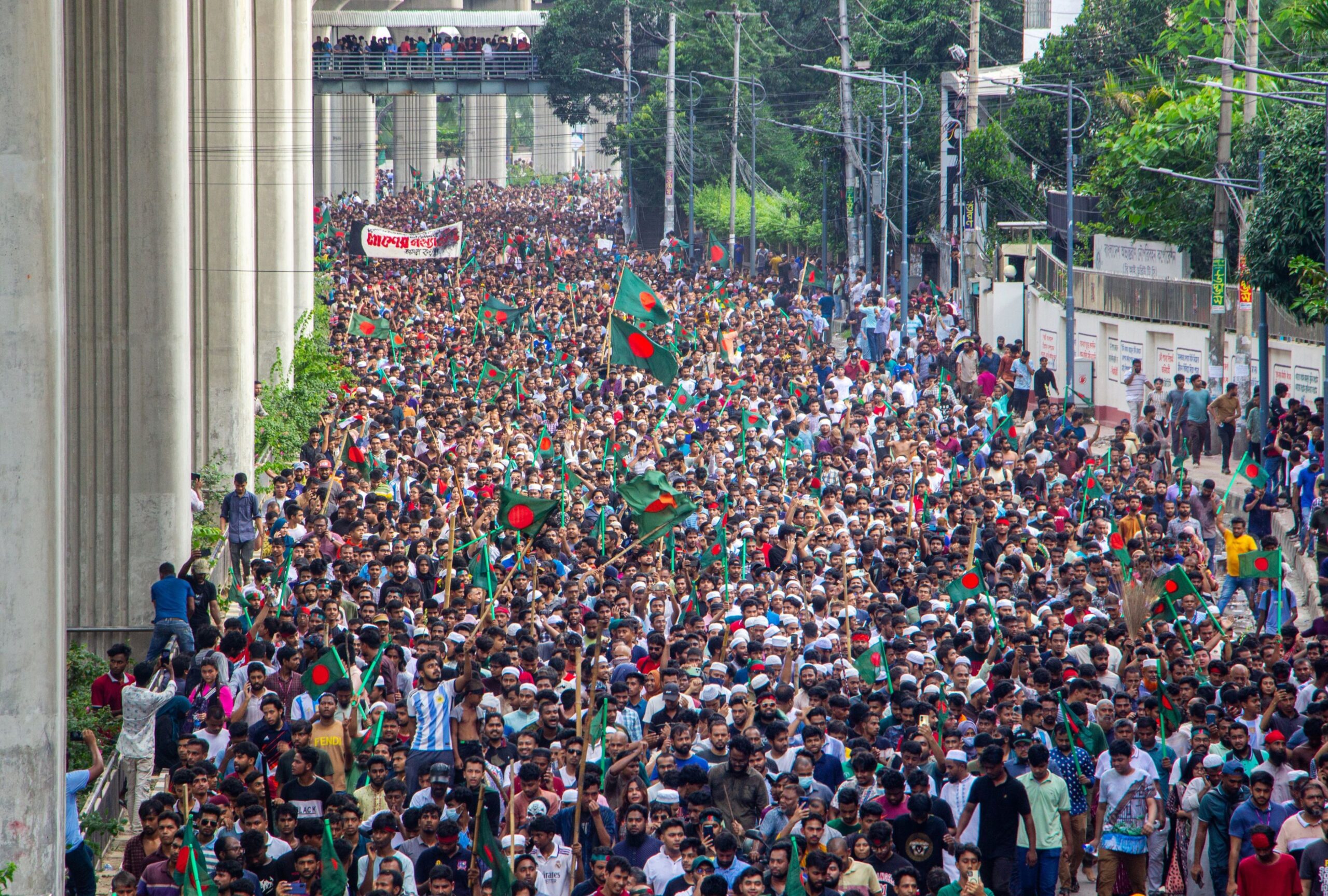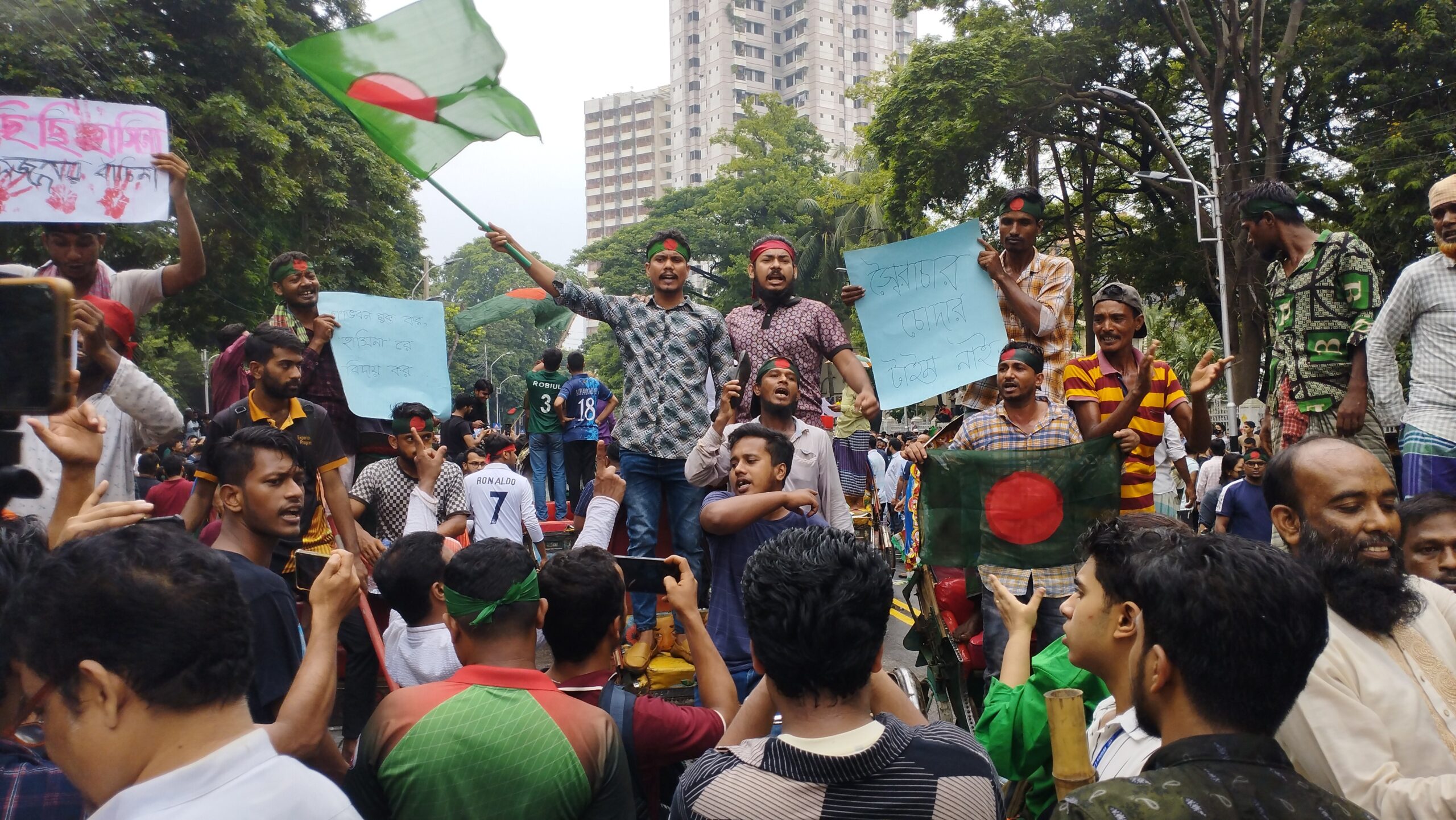Welcome to The Debrief, from the editors at Factal. Each month, we reflect upon an impactful yet underreported story that has significant regional or global implications. We’ll examine how the story has progressed and how Factal’s coverage has shifted to ensure we are always supplying our members with the most up-to-date, accurate, factual reporting.
If you like what you’re reading, sign up to receive The Debrief in your inbox on the first of every month here.
Weeks of student-led protests fast turned into a nationwide movement, forcing Bangladesh Prime Minister Sheikh Hasina from both power and country with a rushed exit in a military helicopter. Now, under Nobel Laureate Muhammad Yunus, the country grapples with making peace as he looks to revive a troubled economy, reinstate law and order after one of the country’s deadliest demonstrations, and prepare a fractured society for democratic elections.
On August 5, Sheikh Hasina, the longest-serving prime minister of Bangladesh, resigned from office and fled the country. Her exit followed the deaths of several hundreds at student-led protests that started against government job quotas before snowballing into a mass uprising against Hasina’s authoritarian administration.
The final tipping point came after at least 90 people were reported killed at protests the day before. Protesters ignored a nationwide “shoot-on-sight” curfew and marched toward Hasina’s residence, giving her a reported 45 minutes to leave the country.
Videos circulated on social media showed a jubilant crowd storming her residence and laying claim to her belongings, from giant fish to Hasina’s infamous sarees. The police, who had participated in the crackdown at the behest of Hasina, went into hiding in fear of retaliation. Military chief Gen. Waker-uz-Zamam then announced “temporary control” of the country as soldiers were deployed to calm the thousands who had since moved on to attack buildings associated with Hasina’s party and family, before an interim government led by Muhammad Yunus, Nobel laureate and long-time critic of Hasina, was called in.
The fall of the ruling Awami League was a long time coming for many reasons even if the quota system limiting jobs for some 400,000 graduates every year amid high unemployment – that benefited the party – was the catalyst for the uprising, Factal senior editor and South Asia expert Halima Mansoor said.
“Yunus’s government…wants to reform things so that when elections happen, they happen under a system with empowered institutions.”
“The fact is that the ruling party was seen as taking advantage of its hold on the country for so many years,” Mansoor said. “And it…abused its power via the police and other government bodies.” Over the course of her rule, Hasina’s government has been accused of corruption, suppressing the press and public opinion, and abusing human rights.
“There were regular people [at the protests], some too young to even benefit from the quota and some past the age for applying for government jobs,” Mansoor said. “But it had been 15 years and they’d had enough…and the deaths were definitely part of the turning point.”
The death toll in the government’s crackdown is understood to be in the hundreds, but Mansoor says the rushed burials without mandated autopsies that took place during the unrest may mean a real toll is never known.
In two short weeks after taking over, Yunus’ administration found anomalies that suggest economic data was manipulated, potentially further proof of damage done by the regime that left Bangladesh in debt to the tune of $156 billion. It also started to root out corruption, with a commission set to investigate at least 41 former ministers and lawmakers who belonged to Hasina’s Awami League between 2009 and 2024.
“A lot of optimistic young people in Bangladesh are probably looking at [this as the] moment in history where the country can turn a new leaf. It’s sort of like a metamorphosis of sorts that they want.”
The interim government has also cleared the path of the Pakistan-aligned Jamaat-e-Islami to contest in any future elections for the first time since 2013. It revoked a ban on the party under the anti-terrorism law by Hasina’s government, which accused it of inciting violence during the protests. The party now seeks to restore its registration with the country’s election commission, however, the interim government seems in no rush to hold elections at this time.
“Under Bangladesh’s legal system, there isn’t much written about the tenure of the interim government,” Mansoor said, referring to the absence of a deadline for the transitional government to hold polls. “This sort of gives Yunus’s government some leeway because they…want to reform things so that when elections happen, they happen under a system with empowered institutions.”
The pressure to rush to polls could also come from the military, whose leadership has assigned itself the task of appointing a new administration. Bangladesh has a long history of military coups and army rule, and according to some reports, its top officials played a role in convincing Hasina to step down. The military now also faces shake-ups in the upper echelons of its leadership.
“But we don’t know how deep these reforms will go in the military,” Mansoor said. “And we don’t know how much the interim government wants to push the military, because they also need peace for desired reforms.”
Though Yunis’ interim government is yet to present an outline of reforms, including for a transition of power, Mansoor says there is much renewed hope for a Bangladesh that has long been denied free and fair elections under Hasina’s rule.
“[It looks like] they have this opportunity…a lot of optimistic young people in Bangladesh are probably looking at [this as the] moment in history where the country can turn a new leaf. It’s sort of like a metamorphosis of sorts that they want.”
Written by Awais Ahmad. Edited by Halima Mansoor and Bada Kim.
Further reading:
- Review and follow Factal’s coverage of unrest in Bangladesh (members link)
- Scan this timeline of July protests by Al Jazeera
- Watch this documentary on the nexus between Bangladesh’s army and former PM Sheikh Hasina
- Read Amnesty International’s report on the crackdown against news outlet Prothom Alo

Thanks for reading! If you enjoyed this edition, sign up here to receive The Debrief in your inbox on the first of every month.
Top photo: Students protest against then Prime Minister Sheikh Hasina’s administration at the Shaheed Minar monument in Dhaka, Bangladesh, on August 3. (Image: Flickr/Mohammad Tanbiruzzaman Koushal)
Factal gives companies the facts they need in real time to protect people, avoid disruptions and drive automation when the unexpected happens.
Try Factal for free or talk with our sales team (sales@factal.com) for a demo.

